LAWSUITS NEWS & LEGAL INFORMATION
Car Crashworthiness and Auto Accident Law
Car crashworthiness refers to how well a vehicle protects its occupants in the event of an auto accident. Vehicle crashworthiness involves the "second collision" in a vehicle accident- the collision in which the occupants of the vehicle collide with the interior of the vehicle, which can result in injury to the occupants. Safety features that comprise car crashworthiness include airbags, seat belts, headrests, roll bars and crumple zones. Any feature that is designed to minimize an occupant's injury - including preventing the occupant from being ejected from the vehicle - is included in vehicle crashworthiness.
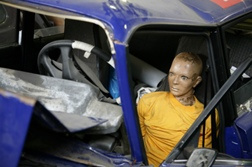 Vehicle manufacturers have a responsibility to design vehicles that are crashworthy. This means that when the vehicle is designed, the manufacturer must take into account the possibility that the vehicle will be involved in an accident. Failure on the part of the vehicle to adequately protect occupants could mean that the vehicle manufacturer is liable for any injury to the people in that vehicle at the time of the crash. Injuries that can result from a vehicle that is not adequately crashworthy include spinal injuries, brain injuries and internal injuries.
Vehicle manufacturers have a responsibility to design vehicles that are crashworthy. This means that when the vehicle is designed, the manufacturer must take into account the possibility that the vehicle will be involved in an accident. Failure on the part of the vehicle to adequately protect occupants could mean that the vehicle manufacturer is liable for any injury to the people in that vehicle at the time of the crash. Injuries that can result from a vehicle that is not adequately crashworthy include spinal injuries, brain injuries and internal injuries.
Car Crash Statistics
According to the NHTSA there were 33,808 highway deaths in 2009 and that number decreased by 1,000 in 2010. Although 2010 was the safest driving year on record since 1949, car crashes remain the leading cause of death in people ages three to 39. Each year more than 43,000 Americans still die in auto accidents.
The Insurance Institute for Highway Safety (IIHS) reports that from 1982 until 2005, US driver death rates per million passenger vehicles registered decreased 51 percent. The report noted that most of that drop came from frontal crashes, in which driver death rates decreased 53 percent, due to such factors as frontal airbags, higher seatbelt use and more crash-worthy vehicles. In contrast, driver death rates in side crashes decreased 42 percent during that time.
The NHTSA has set standards that auto manufacturers must meet to receive a crashworthiness rating for different types of crashes. Vehicles are tested for their performance in frontal collisions, side-impact crashes and rear-impact crashes. Vehicles are then given a rating based on the chance of serious injury.
Ratings for frontal crashes: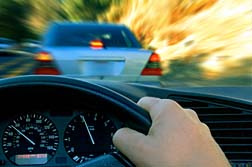 The Insurance Institute for Highway Safety (IIHS) also measures car crashworthiness. The IIHS categories for car crashworthiness are based on the vehicle's performance in high-speed front and side crash tests, rollover tests and evaluations of seat/headrest restraints. Vehicles are then put into one of four categories: good, acceptable, marginal or poor.
The Insurance Institute for Highway Safety (IIHS) also measures car crashworthiness. The IIHS categories for car crashworthiness are based on the vehicle's performance in high-speed front and side crash tests, rollover tests and evaluations of seat/headrest restraints. Vehicles are then put into one of four categories: good, acceptable, marginal or poor.
There are differences between the NCAP tests and the IIHS tests. In addition to frontal crash tests, the IIHS performs tests that involve what are called offset crashes. Offset crashes occur in frontal collisions, but only involve a portion of the front of the vehicle, such as when a vehicle strikes something with only the drivers' side front of the car. Offset crashes typically involve more intrusion into the occupant compartment of the vehicle than full, head-on collisions.
Car Crashworthiness and Auto Defect Lawsuits
Issues with car crashworthiness involve manufacturing defects, such as when an airbag fails to deploy; design defects, such as when a fuel tank is placed in a location that makes it likely to explode on impact; or failure to warn, which is when the manufacturer knows that there is something dangerous about the vehicle but does not warn consumers about that danger.
Problems that may cause serious injuries or death include door latch failure, car seat problems, defective airbags, defective headrests, defective seatbelts, defective tires, faulty fuel tanks, passenger van rollovers, roof crush, side impacts, SUV rollovers and underride accidents.
Car Door Latch Failure: Door Latch Failure Injury
Door latches are vital to the safety of a vehicle. The latches should be designed to stay closed in automobile accidents to prevent the vehicle's occupants from being ejected from the vehicle. If the door latch fails, the door could open, allowing the occupant to be thrown from the vehicle and increasing the risk of serious injury. Causes of door latch failure include mechanical problems, improper design, improper construction and improper installation.
Car Seat Backs: Car Seat Back Injury
Car seat backs should stay upright in an accident to prevent injury to the person sitting in the seat. However, some seat backs are known to have collapsed in an accident, either from the initial force of the accident or from the occupant's weight being thrown around during the collision, causing serious neck and spinal injuries to vehicle occupants.
Defective Airbags: Car Airbag Injury
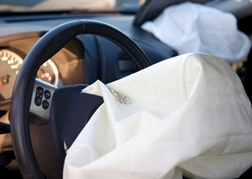 There are a variety of problems that can occur with defective airbags, including side airbags and curtain airbags . These problems include airbags that fail to deploy, airbags that deploy unnecessarily and airbags that deploy with so much force that they cause injury and even death. Problems with airbags may be caused by poor design, inadequate censors and other defects. Injuries caused by defective airbags include abrasions, lacerations, hearing problems, head and brain injuries, neck injuries, broken bones, chemical burns and, in severe cases, death.
There are a variety of problems that can occur with defective airbags, including side airbags and curtain airbags . These problems include airbags that fail to deploy, airbags that deploy unnecessarily and airbags that deploy with so much force that they cause injury and even death. Problems with airbags may be caused by poor design, inadequate censors and other defects. Injuries caused by defective airbags include abrasions, lacerations, hearing problems, head and brain injuries, neck injuries, broken bones, chemical burns and, in severe cases, death.
Defective Headrests: Headrest Neck Injury
Headrests are designed to prevent vehicle occupants from suffering serious neck injuries in an accident. Those injuries can be caused when the person's body is thrown back into his seat during a collision. However, when headrests are improperly designed, vehicle occupants can suffer severe injury, including whiplash, concussion, skull fractures, spinal fractures and brain damage.
Defective Seatbelts: Car Safety Belt Injury
Seatbelts are designed to protect vehicle occupants from serious injury; however, seatbelts that fail to perform as designed can cause devastating injuries. Seatbelt problems include mechanical defects, design defects and mechanical component failures. Injuries associated with defective seatbelts include strangulation, broken bones, head trauma and death.
Defective Tires: Tire Failure Injury
A vehicle's tires should be safe and sturdy—they should be designed and manufactured to properly handle a vehicle load and the speed the vehicle is driven at. However, there have been problems with defective tires that can lead to fatal accidents and serious injuries. These problems include tires that crack or split, blow out or experience tread separation.
Faulty Fuel Tank: Fuel Tank Failure Injury
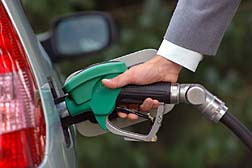 Defective fuel tanks can cause devastating injury to vehicle occupants. A main issue is that improperly designed fuel tanks can cause fires if the vehicle they are a component of is involved in an accident. Such fires are dangerous and can cause explosions, risking the lives of anyone who is trapped inside a vehicle. Issues with fuel tanks include punctures, tearing, fuel line separation, and filter cap separation.
Defective fuel tanks can cause devastating injury to vehicle occupants. A main issue is that improperly designed fuel tanks can cause fires if the vehicle they are a component of is involved in an accident. Such fires are dangerous and can cause explosions, risking the lives of anyone who is trapped inside a vehicle. Issues with fuel tanks include punctures, tearing, fuel line separation, and filter cap separation.
Passenger Van Rollover: Van Rollover Injury
Passenger van rollover accidents can be devastating. Some passenger vans are unstable because they have a high center of gravity and a narrow wheelbase. This makes some vans more prone to rollover accidents.
Roof Crush: Car Roof Caving Injury
When vehicles are involved in rollover accidents, occupants rely on the roof or roll bar to protect them. However, some vehicles experience roof crush, which is when the roof of the vehicle does not maintain its structural integrity in a rollover accident. Injuries caused by roof crush can be traumatic, including neck and spinal injuries, paralysis and even death.
Side Impact: Side Impact Injury
The frame of a vehicle is more thin on the sides than at the front or back, which makes side impact collisions dangerous for occupants of the vehicles. Features that can protect vehicle occupants in a side collision are strong doors and side airbags.
SUV Rollover: SUV Rollover Injury
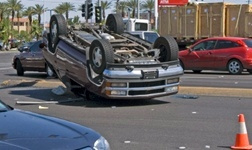 SUV rollovers are incredibly dangerous to vehicle occupants. Unfortunately, because they have a high center of gravity and narrow wheelbases, combined with being top heavy, SUVs are prone to rollover accidents, especially when the driver attempts to perform an evasive maneuver—such as swerving—at a high speed. Other circumstances that can lead to SUV rollovers include tire failures, inadequate brakes and poor stability design.
SUV rollovers are incredibly dangerous to vehicle occupants. Unfortunately, because they have a high center of gravity and narrow wheelbases, combined with being top heavy, SUVs are prone to rollover accidents, especially when the driver attempts to perform an evasive maneuver—such as swerving—at a high speed. Other circumstances that can lead to SUV rollovers include tire failures, inadequate brakes and poor stability design.
Underride Accidents: Rear Bumper Underride Injury
Underride accidents occur when vehicles with uneven bumper heights collide and one vehicle's rear bumper forces the bumper of another vehicle to go beneath it. These can be the result of accidents between SUVs or vans and cars, mainly because there are no bumper requirements for SUVs or vans—car bumpers must all be within a few inches—or accidents involving tractor-trailers.
Under crashworthiness law or doctrine the auto maker is liable, in negligence and/or strict liability, for the enhanced injuries sustained from the secondary collision in an accident, meaning the passenger's impact inside the car. A crashworthiness attorney can sometimes claim damages in a defective vehicle litigation or crashworthiness lawsuit.
In a crashworthiness lawsuit, the accident itself is often irrelevant. Rather, car crashworthiness law looks at whether the manufacturer designed the vehicle and its components so that it is safe for any reasonably foreseeable use, and the use includes the possibility of its involvement in a collision.
Congress and some state legislatures have made strides in establishing that a vehicle manufacturer's compliance with government safety standards is a valid defense to a vehicle defect claim. However, courts still rule that, regardless of federal standards, manufacturers have a duty to build a vehicle that is as safe as is reasonably possible under the present state of mechanical technology, vehicle design, and safety.
An attorney experienced in crashworthiness law can help with your legal options and can call on experts on car crashworthiness design and defects.
Last updated on
FREE CAR CRASHWORTHINESS LAWSUIT EVALUATION
Send your Car Crashworthiness claim to a lawyer who will review your claim at NO COST or obligation.
GET LEGAL HELP NOW
GET LEGAL HELP NOW
Car Door Latch | Car Seat Backs | Defective Airbags | Defective Headrests
Defective Seatbelts | Defective Tires | Faulty Fuel Tank | Passenger Van Rollover
Roof Crush | Side Impact | SUV Rollover | Underride Accidents
Defective Seatbelts | Defective Tires | Faulty Fuel Tank | Passenger Van Rollover
Roof Crush | Side Impact | SUV Rollover | Underride Accidents
Vehicle Crashworthiness
 Vehicle manufacturers have a responsibility to design vehicles that are crashworthy. This means that when the vehicle is designed, the manufacturer must take into account the possibility that the vehicle will be involved in an accident. Failure on the part of the vehicle to adequately protect occupants could mean that the vehicle manufacturer is liable for any injury to the people in that vehicle at the time of the crash. Injuries that can result from a vehicle that is not adequately crashworthy include spinal injuries, brain injuries and internal injuries.
Vehicle manufacturers have a responsibility to design vehicles that are crashworthy. This means that when the vehicle is designed, the manufacturer must take into account the possibility that the vehicle will be involved in an accident. Failure on the part of the vehicle to adequately protect occupants could mean that the vehicle manufacturer is liable for any injury to the people in that vehicle at the time of the crash. Injuries that can result from a vehicle that is not adequately crashworthy include spinal injuries, brain injuries and internal injuries.
Car Crash Statistics
According to the NHTSA there were 33,808 highway deaths in 2009 and that number decreased by 1,000 in 2010. Although 2010 was the safest driving year on record since 1949, car crashes remain the leading cause of death in people ages three to 39. Each year more than 43,000 Americans still die in auto accidents.
The Insurance Institute for Highway Safety (IIHS) reports that from 1982 until 2005, US driver death rates per million passenger vehicles registered decreased 51 percent. The report noted that most of that drop came from frontal crashes, in which driver death rates decreased 53 percent, due to such factors as frontal airbags, higher seatbelt use and more crash-worthy vehicles. In contrast, driver death rates in side crashes decreased 42 percent during that time.
The NHTSA has set standards that auto manufacturers must meet to receive a crashworthiness rating for different types of crashes. Vehicles are tested for their performance in frontal collisions, side-impact crashes and rear-impact crashes. Vehicles are then given a rating based on the chance of serious injury.
Ratings for frontal crashes:
- Five stars = 10 percent or less chance of serious injury
- Four stars = 11 percent to 20 percent chance of serious injury
- Three stars = 21 percent to 35 percent chance of serious injury
- Two stars = 36 percent to 45 percent chance of serious injury
- One star = 46 percent or greater chance of serious injury.
- Five stars = 5 percent or less chance of serious injury
- Four stars = 6 percent to 10 percent chance of serious injury
- Three stars = 11 percent to 20 percent chance of serious injury
- Two stars = 21 percent to 25 percent chance of serious injury
- One star = 26 percent or greater chance of serious injury.
 The Insurance Institute for Highway Safety (IIHS) also measures car crashworthiness. The IIHS categories for car crashworthiness are based on the vehicle's performance in high-speed front and side crash tests, rollover tests and evaluations of seat/headrest restraints. Vehicles are then put into one of four categories: good, acceptable, marginal or poor.
The Insurance Institute for Highway Safety (IIHS) also measures car crashworthiness. The IIHS categories for car crashworthiness are based on the vehicle's performance in high-speed front and side crash tests, rollover tests and evaluations of seat/headrest restraints. Vehicles are then put into one of four categories: good, acceptable, marginal or poor.
There are differences between the NCAP tests and the IIHS tests. In addition to frontal crash tests, the IIHS performs tests that involve what are called offset crashes. Offset crashes occur in frontal collisions, but only involve a portion of the front of the vehicle, such as when a vehicle strikes something with only the drivers' side front of the car. Offset crashes typically involve more intrusion into the occupant compartment of the vehicle than full, head-on collisions.
Car Crashworthiness and Auto Defect Lawsuits
Issues with car crashworthiness involve manufacturing defects, such as when an airbag fails to deploy; design defects, such as when a fuel tank is placed in a location that makes it likely to explode on impact; or failure to warn, which is when the manufacturer knows that there is something dangerous about the vehicle but does not warn consumers about that danger.
Problems that may cause serious injuries or death include door latch failure, car seat problems, defective airbags, defective headrests, defective seatbelts, defective tires, faulty fuel tanks, passenger van rollovers, roof crush, side impacts, SUV rollovers and underride accidents.
Car Door Latch Failure: Door Latch Failure Injury
Door latches are vital to the safety of a vehicle. The latches should be designed to stay closed in automobile accidents to prevent the vehicle's occupants from being ejected from the vehicle. If the door latch fails, the door could open, allowing the occupant to be thrown from the vehicle and increasing the risk of serious injury. Causes of door latch failure include mechanical problems, improper design, improper construction and improper installation.
Car Seat Backs: Car Seat Back Injury
Car seat backs should stay upright in an accident to prevent injury to the person sitting in the seat. However, some seat backs are known to have collapsed in an accident, either from the initial force of the accident or from the occupant's weight being thrown around during the collision, causing serious neck and spinal injuries to vehicle occupants.
Defective Airbags: Car Airbag Injury
 There are a variety of problems that can occur with defective airbags, including side airbags and curtain airbags . These problems include airbags that fail to deploy, airbags that deploy unnecessarily and airbags that deploy with so much force that they cause injury and even death. Problems with airbags may be caused by poor design, inadequate censors and other defects. Injuries caused by defective airbags include abrasions, lacerations, hearing problems, head and brain injuries, neck injuries, broken bones, chemical burns and, in severe cases, death.
There are a variety of problems that can occur with defective airbags, including side airbags and curtain airbags . These problems include airbags that fail to deploy, airbags that deploy unnecessarily and airbags that deploy with so much force that they cause injury and even death. Problems with airbags may be caused by poor design, inadequate censors and other defects. Injuries caused by defective airbags include abrasions, lacerations, hearing problems, head and brain injuries, neck injuries, broken bones, chemical burns and, in severe cases, death.
Defective Headrests: Headrest Neck Injury
Headrests are designed to prevent vehicle occupants from suffering serious neck injuries in an accident. Those injuries can be caused when the person's body is thrown back into his seat during a collision. However, when headrests are improperly designed, vehicle occupants can suffer severe injury, including whiplash, concussion, skull fractures, spinal fractures and brain damage.
Defective Seatbelts: Car Safety Belt Injury
Seatbelts are designed to protect vehicle occupants from serious injury; however, seatbelts that fail to perform as designed can cause devastating injuries. Seatbelt problems include mechanical defects, design defects and mechanical component failures. Injuries associated with defective seatbelts include strangulation, broken bones, head trauma and death.
Defective Tires: Tire Failure Injury
A vehicle's tires should be safe and sturdy—they should be designed and manufactured to properly handle a vehicle load and the speed the vehicle is driven at. However, there have been problems with defective tires that can lead to fatal accidents and serious injuries. These problems include tires that crack or split, blow out or experience tread separation.
Faulty Fuel Tank: Fuel Tank Failure Injury
 Defective fuel tanks can cause devastating injury to vehicle occupants. A main issue is that improperly designed fuel tanks can cause fires if the vehicle they are a component of is involved in an accident. Such fires are dangerous and can cause explosions, risking the lives of anyone who is trapped inside a vehicle. Issues with fuel tanks include punctures, tearing, fuel line separation, and filter cap separation.
Defective fuel tanks can cause devastating injury to vehicle occupants. A main issue is that improperly designed fuel tanks can cause fires if the vehicle they are a component of is involved in an accident. Such fires are dangerous and can cause explosions, risking the lives of anyone who is trapped inside a vehicle. Issues with fuel tanks include punctures, tearing, fuel line separation, and filter cap separation.
Passenger Van Rollover: Van Rollover Injury
Passenger van rollover accidents can be devastating. Some passenger vans are unstable because they have a high center of gravity and a narrow wheelbase. This makes some vans more prone to rollover accidents.
Roof Crush: Car Roof Caving Injury
When vehicles are involved in rollover accidents, occupants rely on the roof or roll bar to protect them. However, some vehicles experience roof crush, which is when the roof of the vehicle does not maintain its structural integrity in a rollover accident. Injuries caused by roof crush can be traumatic, including neck and spinal injuries, paralysis and even death.
Side Impact: Side Impact Injury
The frame of a vehicle is more thin on the sides than at the front or back, which makes side impact collisions dangerous for occupants of the vehicles. Features that can protect vehicle occupants in a side collision are strong doors and side airbags.
SUV Rollover: SUV Rollover Injury
 SUV rollovers are incredibly dangerous to vehicle occupants. Unfortunately, because they have a high center of gravity and narrow wheelbases, combined with being top heavy, SUVs are prone to rollover accidents, especially when the driver attempts to perform an evasive maneuver—such as swerving—at a high speed. Other circumstances that can lead to SUV rollovers include tire failures, inadequate brakes and poor stability design.
SUV rollovers are incredibly dangerous to vehicle occupants. Unfortunately, because they have a high center of gravity and narrow wheelbases, combined with being top heavy, SUVs are prone to rollover accidents, especially when the driver attempts to perform an evasive maneuver—such as swerving—at a high speed. Other circumstances that can lead to SUV rollovers include tire failures, inadequate brakes and poor stability design.
Underride Accidents: Rear Bumper Underride Injury
Underride accidents occur when vehicles with uneven bumper heights collide and one vehicle's rear bumper forces the bumper of another vehicle to go beneath it. These can be the result of accidents between SUVs or vans and cars, mainly because there are no bumper requirements for SUVs or vans—car bumpers must all be within a few inches—or accidents involving tractor-trailers.
Car Crashworthiness Law
In a crashworthiness lawsuit, the accident itself is often irrelevant. Rather, car crashworthiness law looks at whether the manufacturer designed the vehicle and its components so that it is safe for any reasonably foreseeable use, and the use includes the possibility of its involvement in a collision.
Congress and some state legislatures have made strides in establishing that a vehicle manufacturer's compliance with government safety standards is a valid defense to a vehicle defect claim. However, courts still rule that, regardless of federal standards, manufacturers have a duty to build a vehicle that is as safe as is reasonably possible under the present state of mechanical technology, vehicle design, and safety.
An attorney experienced in crashworthiness law can help with your legal options and can call on experts on car crashworthiness design and defects.
Car Crashworthiness Injury Legal Help
If you or a loved one has suffered from an auto accident in which the vehicle was not "crashworthy", please click the link below to send your complaint to a lawyer to evaluate your claim at no cost or obligation.Last updated on
CAR CRASHWORTHINESS LEGAL ARTICLES AND INTERVIEWS
New Generation of "Advanced" Airbags—Better or Worse?

GMC Side-Curtain Airbags Defective?

Nissan Recalls More Than a Half-Million Vehicles


November 2, 2011
As vehicle manufacturers are adding "new and improved" airbags—including side airbags and curtain airbags—to their vehicles (the NHTSA gave automobile manufacturers until 2012 to provide advanced airbags), these airbags are also causing accidents. While some airbags do not deploy in a collision, others deploy without the vehicle being involved in an accident. READ MORE
GMC Side-Curtain Airbags Defective?

October 18, 2011
When the side-curtain airbags in Lisa Jarrett's GMC Envoy Excel deployed without cause—there hadn't been a car accident—she thought "it was a gunshot because you see this flash of light," then there was another bang as the steering wheel airbag exploded. READ MORE
Nissan Recalls More Than a Half-Million Vehicles

November 12, 2010
Nissan revealed late yesterday that it is recalling more than a half-million vehicles to remedy problems with steering problems and battery cables. In rare cases, a failure could be devastating. READ MORE
READ MORE Accidents Settlements and Legal News
READ MORE Automotive Settlements and Legal News
READ MORE Defective Products Settlements and Legal News
READ MORE Automotive Settlements and Legal News
READ MORE Defective Products Settlements and Legal News

READER COMMENTS
Anonymous
on
The greatest mystery that I want to come out is the way I came out unscathed in that accident. What happened was that I had my crown of my head propped against the seat in front of me as I slept. Awakening from my sleep I found that the seat I had my head on had uprooted itself from its position and was twisted pressing the passenger sitting on it to the opposite seat and unable to free her self out.
I believe that when an accident happens we tend to move at the motion the vehicle was in when it suddenly stops. So can someone explain to me what would have happened for the seat to move while my head was on it and i came out without even a head ache.
North Carolina
on
Missouri
on
North Carolina
on
North Carolina
on
North Carolina
on
Ohio
on
Oregon
on
I have pictures taken by a witness before the rescuers reached my car to use "jaws of life" to get me out.
Ohio
on
I have photos of the accident that were taken at the scene by the state highway patrol.
Florida
on
I do not have a problem with the driver who struck me from behind. Accidents happen and her insurance company will repair the damage. My concern is the fact that the air bags did not deploy. What if I am forced off the road or hit head on at 70 MPH, can I feel confident that I am Safe?
Florida
on
Texas
on